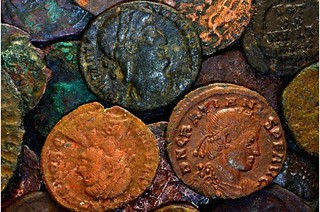
PREV ARTICLE
NEXT ARTICLE
FULL ISSUE
PREV FULL ISSUE
X-RAY SPECTROSCOPY ROMAN COINS STUDYResearchers from the University of Oxford and the University of Warwick studied three Roman coins with advanced non-destructive techniques. -Editor
To reach this conclusion, researchers brought three Roman coins to the Science and Technology Facilities Council's ISIS Neutron and Muon Source for analysis. When high-value artifacts need to be analyzed researchers are generally required to employ non-destructive techniques. Researchers from the University of Oxford and the University of Warwick brought three Roman coins to the ISIS facility. The team wanted to see if the coins had been surface enriched, or secretly mixed with other metals. By doing this, the researchers could deduce a number of things about the society they came from, including the level of economic stability. The coins analyzed were issued during the reigns of three different Roman emperors:
To measure the purity of the gold coins they used muonic X-ray emission spectroscopy, a totally non-destructive analytical process that involves firing negative muons at the artifact. The muons are then captured by the atoms within the coins, which then emit a 'fingerprint' of muonic X-rays that are unique to the chemical element they came from. Lead author Dr. George Green of the University of Oxford said: "The results from the surface level analyzes of these coins suggested that they were very high purity gold. However, these measurements were from the first few fractions of millimeters of the coins, so there was a very reasonable 'what if.' What if they're actually made of something different beneath the surface? We know that the Romans deliberately surface enriched their silver coins to 'hide' the fact there was a lot of copper in them, so it is plausible something similar happened to the gold. Our work at ISIS enabled us to sample the very center of these coins totally non-destructively and conclusively show that the high purity seen on the surface was representative of the composition of the 'core' of the coin. At a basic level it is further testament to the economic health of the Roman Empire, but these conclusions are also useful for researchers who need to employ non or negligibly-destructive techniques on the surfaces of Roman gold coins. Now they can be confident the surface is representative of the bulk of these objects."
To read the complete article, see:
Wayne Homren, Editor The Numismatic Bibliomania Society is a non-profit organization promoting numismatic literature. See our web site at coinbooks.org. To submit items for publication in The E-Sylum, write to the Editor at this address: whomren@gmail.com To subscribe go to: https://my.binhost.com/lists/listinfo/esylum All Rights Reserved. NBS Home Page Contact the NBS webmaster 
|

